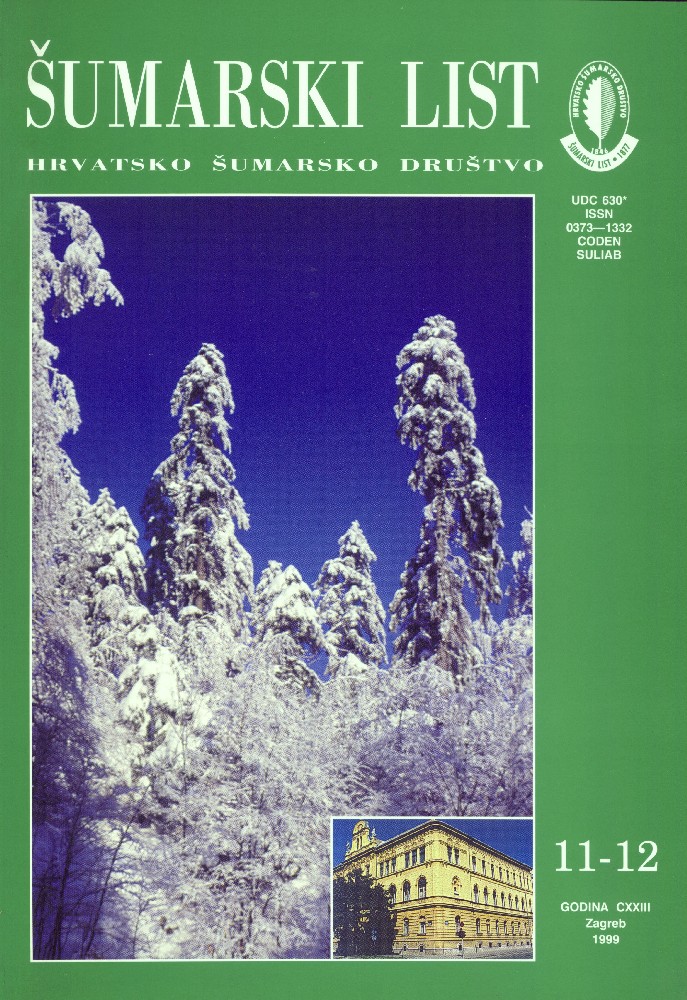| |
| IZVORNI ZNANSTVENI ČLANCI |
| |
|
|
| Kajba, D., Bogdan, S., Vratarić, P. | UDK 630* 238 + 114.2 (001) (Salix alba L., Alnus glutinosa (L.) Gaertn.) |
| Growth of white willow (Salix alba L.) Clones in Mixed Plantation with black Alder (Alnus glutinosa (L.) Gaertn.) on the peat-clay type of soil in Podravina (Croatia)
pdf
HR
EN
|
523 |
| Pintarić, K. | UDK 630* 231 + 236. 001 (Pinus nigra Arn.) |
| The Analysis of Structure and Quality of Natural Black Pine Thicket
pdf
HR
EN
|
533 |
| |
| PREGLEDNI ČLANCI |
| |
|
|
| Bertović, S. | UDK 630* 113 + 188 |
| The Relief and Its Spacial Distribution
pdf
HR
EN
|
543 |
| |
| PRETHODNO PRIOPĆENJE |
| |
|
|
| Frković, A. | UDK 630* 156 (Ursus arctos L.) |
| The Mortality of the European Brown Bear (Ursus arctos L.) in Mountainous Regions of Croatia During (1991-1995) and After (1996) Homeland War
pdf
HR
EN
|
565 |
Summary: The effect of the first three years (1990-1992) war in Croatia on wild animals has been reported by Frković (1993), Mikuska (1993), Raguž i Grubešić (1993) and Huber (1993). This study reports on the mortality of European brown bears (Ursus arctos) in Croatia during the entire duration of war (1991 - 1995) and the first post-war year (1996). Croatia has been estimated to host 400 European brown bears (Ursus arctos) before the Homeland war started in 1991 (Huber and Frković 1993).The initial and not fully confirmed data indicate the during the war and the first post-war year at least 57 bears died in relation to the war in the area of Lika and Gorski kotar covering roughly 6,000 km2, where some 350 of Croatian bears lived before the war (Figure 2). Legal hunting has been excluded from this statistics. Forty-one (72%) bears were adults and 16 (28%) cubs and subadults (Table 1, Figure 2). Among adult bears 11 (27%) were males, 9 (22%) females and 21 (51%) of undetermined sex. The known immediate causes of bear deaths were: 10 (17%) by shooting on the fire line during combats, troop and patrol movements, or soldiers on guard, 14 (25%) by land mines and shelling, 20 (35%) by intentional illegal shooting with military weapons, and 13 (23%) by den disturbances, captures of live cubs and vehicle collisions. Bears with severe body defects still may be seen in Gorski kotar.Rough estimates indicate that the war and post-war bear loses caused a population drop of 5 - 30% (Frković 1997). It is not yet possible to evaluate the full influence of war related disturbances on the bear reproduction, horizontal and vertical migrations, as well as the impact on the entire population. The bear habitat in Croatia suffered local destruction (Figure 5) but doesn´t seem to have suffered significant overall loses due to the war (Figure 6). This raises optimism that the bear population will recover from the war related mortality. Present attention has to be paid to other threats for long-term survival of brown bears in Croatia and neighboring countries within the Dinara Mountains range.
Key words: European brown bear (Ursus arctos); Mountainous Croatia; Homeland war; land mines; shelling; illegal killing; mortality |
| |
| STRUČNI ČLANCI |
| |
|
|
| Lisjak, Z. | UDK 630* 325 + 326 |
| Optimal use of Stemwood in Forest Harvesting
pdf
HR
EN
|
573 |
| Tolić, I. | UDK 630* 176.1 + 181.1 (Quercus macedonica A.D.C.) |
| Macedonian Oak - Quercus trojana Webb (Quercus macedonica A.D.C.) in Dalmatinska Zagora
pdf
HR
EN
|
581 |



